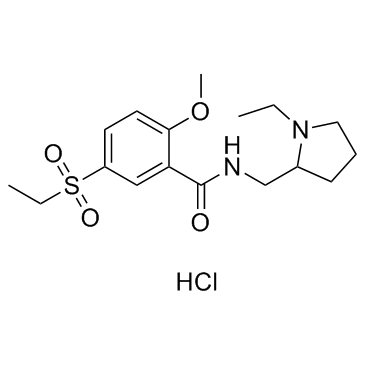Sultopride hydrochloride (LIN-1418 hydrochloride) |
| Catalog No.GC30944 |
Sultopride hydrochloride (LIN-1418 hydrochloride) (LIN-1418 hydrochloride) is a selective antagonist of dopamine D2 receptor.
Products are for research use only. Not for human use. We do not sell to patients.

Cas No.: 23694-17-9
Sample solution is provided at 25 µL, 10mM.
Sultopride hydrochloride is a selective antagonist of dopamine D2 receptor.
Sultopride hydrochloride is a selective antagonist of dopamine D2 receptor. DOPAC and HVA levels in the striatum, the nucleus accumbens and the medial prefrontal cortex are higher in the rats treated with Sultopride hydrochloride and sulpiride than those of the controls. In the striatum, DOPAC and HVA levels are higher in the Sultopride hydrochloride-treated rats than the sulpiride-treated rats (p<0.05). In the nucleus accumbens, DOPAC levels are higher in the Sultopride hydrochloride-treated rats than sulpiride treated rats (p<0.05). In the Sultopride hydrochloride-treated rats, DOPAC and HVA levels are higher in the striatum or in the nucleus accumbens than in the medial prefrontal cortex (p<0.05)[1].
[1]. Moriuchi K, et al. Differences in effects of sultopride and sulpiride on dopamine turnover in rat brain. Neurochem Res. 1995 Jan;20(1):95-9.
|
Animal experiment: |
Thirty-six male Sprague-Dawley rats weighing 180 to 220 g are used in this study. The rats are divided into three groups of 6 each. One group is intraperitoneally injected with Sultopride hydrochloride (100 mg/kg body weight), the second group with sulphide (100 mg/kg body weight), and the third group with normal saline. One hundred minutes after the initial treatments, apomorphine (0.1 mg/kg body weight, dissolved in saline ad libitum) is administered subcutaneously to the three groups, and 20 minutes later the rats are sacrificed. The third group serves as controls[1]. |
|
References: [1]. Moriuchi K, et al. Differences in effects of sultopride and sulpiride on dopamine turnover in rat brain. Neurochem Res. 1995 Jan;20(1):95-9. |
|
| Cas No. | 23694-17-9 | SDF | |
| Canonical SMILES | O=C(NCC1N(CC)CCC1)C2=CC(S(=O)(CC)=O)=CC=C2OC.Cl | ||
| Formula | C17H27ClN2O4S | M.Wt | 390.93 |
| Solubility | DMSO : 50 mg/mL (127.90 mM);Water : 50 mg/mL (127.90 mM) | Storage | Store at -20°C |
| General tips | Please select the appropriate solvent to prepare the stock solution according to the
solubility of the product in different solvents; once the solution is prepared, please store it in
separate packages to avoid product failure caused by repeated freezing and thawing.Storage method
and period of the stock solution: When stored at -80°C, please use it within 6 months; when stored
at -20°C, please use it within 1 month. To increase solubility, heat the tube to 37°C and then oscillate in an ultrasonic bath for some time. |
||
| Shipping Condition | Evaluation sample solution: shipped with blue ice. All other sizes available: with RT, or with Blue Ice upon request. | ||
| Prepare stock solution | |||

|
1 mg | 5 mg | 10 mg |
| 1 mM | 2.558 mL | 12.79 mL | 25.58 mL |
| 5 mM | 0.5116 mL | 2.558 mL | 5.116 mL |
| 10 mM | 0.2558 mL | 1.279 mL | 2.558 mL |
Step 1: Enter information below (Recommended: An additional animal making an allowance for loss during the experiment)
 g
g
 μL
μL

Step 2: Enter the in vivo formulation (This is only the calculator, not formulation. Please contact us first if there is no in vivo formulation at the solubility Section.)
Calculation results:
Working concentration: mg/ml;
Method for preparing DMSO master liquid: mg drug pre-dissolved in μL DMSO ( Master liquid concentration mg/mL, Please contact us first if the concentration exceeds the DMSO solubility of the batch of drug. )
Method for preparing in vivo formulation: Take μL DMSO master liquid, next addμL PEG300, mix and clarify, next addμL Tween 80, mix and clarify, next add μL ddH2O, mix and clarify.
Method for preparing in vivo formulation: Take μL DMSO master liquid, next add μL Corn oil, mix and clarify.
Note: 1. Please make sure the liquid is clear before adding the next solvent.
2. Be sure to add the solvent(s) in order. You must ensure that the solution obtained, in the previous addition, is a clear solution before proceeding to add the next solvent. Physical methods such as vortex, ultrasound or hot water bath can be used to aid dissolving.
3. All of the above co-solvents are available for purchase on the GlpBio website.
Quality Control & SDS
- View current batch:
- Purity: >98.00%
- COA (Certificate Of Analysis)
- SDS (Safety Data Sheet)
- Datasheet
Average Rating: 5 (Based on Reviews and 40 reference(s) in Google Scholar.)
GLPBIO products are for RESEARCH USE ONLY. Please make sure your review or question is research based.
Required fields are marked with *



















